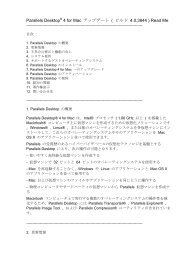[PDF] Parallels Server 5 Bare Metal
[PDF] Parallels Server 5 Bare Metal
[PDF] Parallels Server 5 Bare Metal
Create successful ePaper yourself
Turn your PDF publications into a flip-book with our unique Google optimized e-Paper software.
Choosing a Container ID<br />
Managing Virtual Machines and Containers<br />
Every Container has a numeric ID, also known as Container ID, associated with it. The ID is a 32-bit<br />
integer number beginning with zero and unique for a given <strong>Parallels</strong> server. When choosing an ID<br />
for your Container, please follow the simple guidelines below:<br />
• ID 0 is used for the <strong>Parallels</strong> server itself. You cannot and should not try to create a Container<br />
with ID 0.<br />
• <strong>Parallels</strong> <strong>Server</strong> <strong>Bare</strong> <strong>Metal</strong> reserves the IDs ranging from 0 to 100. Please do not create<br />
Containers with IDs below 101.<br />
The only strict requirement for a Container ID is to be unique for a particular <strong>Parallels</strong> server.<br />
However, if you are going to have several computers running <strong>Parallels</strong> <strong>Server</strong> <strong>Bare</strong> <strong>Metal</strong>, we<br />
recommend assigning different Container ID ranges to them. For example, on server 1 you create<br />
Containers within the range of IDs from 101 to 1000; on server 2 you use the range from 1001 to<br />
2000, and so on. This approach makes it easier to remember on which server a Container has<br />
been created, and eliminates the possibility of Container ID conflicts when a Container migrates<br />
from one <strong>Parallels</strong> server to another.<br />
Another approach to assigning Container IDs is to follow some pattern of Container IP addresses.<br />
Thus, for example, if you have a subnet with the 10.0.x.x address range, you may want to assign<br />
the 17015 ID to the Container with the 10.0.17.15 IP address, the 39108 ID to the Container with<br />
the 10.0.39.108 IP address, and so on. This makes it much easier to run a number of <strong>Parallels</strong><br />
utilities eliminating the necessity to check up the Container IP address by its ID and similar tasks.<br />
You can also think of your own patterns for assigning Container IDs depending on the configuration<br />
of your network and your specific needs.<br />
Before you decide on a new Container ID, you may want to make sure that no Container with this<br />
ID has yet been created on the server. The easiest way to check this is to run the following<br />
command:<br />
# vzlist -a 101<br />
Container not found<br />
This output shows that Container 101 does not exist on the server; otherwise it would be present in<br />
the list.<br />
WARNING! When deciding on a Container ID, do not use IDs that were once assigned to<br />
Containers unless you are sure that no data belonging to the old Containers remains on the server.<br />
Otherwise, the administrator of the newly-created Container may get access to this data—that is,<br />
to the backups of the old Container, its logs, statistics, and so on.<br />
33


![[PDF] Parallels Server 5 Bare Metal](https://img.yumpu.com/18850617/33/500x640/pdf-parallels-server-5-bare-metal.jpg)
![[PDF] Parallels Desktop® 7](https://img.yumpu.com/18852044/1/190x245/pdf-parallels-desktopr-7.jpg?quality=85)
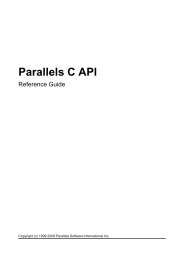
![[PDF] Parallels Python API Reference](https://img.yumpu.com/18850615/1/190x245/pdf-parallels-python-api-reference.jpg?quality=85)

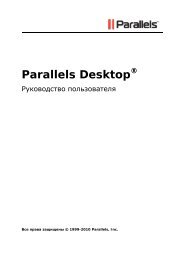
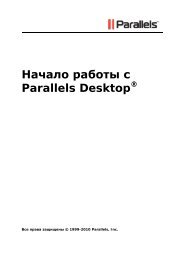

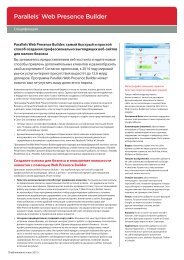



![[PDF] Parallels Python API Reference](https://img.yumpu.com/18850529/1/190x245/pdf-parallels-python-api-reference.jpg?quality=85)

